Author: Jay Jo; Source: Tiger Research Reports; Compiler: Vernacular Blockchain
Brief summary:
The Asian market is complex and diverse, with different regulations and cultures. To participate in the Web3 industry, it is necessary to have a deep understanding of the characteristics of each country.
Asia has a large population of young, digital natives, which provides great potential for its leading position in the Web3 market, especially in super applications and consumer applications.
On-chain data shows that the Asian Web3 market is growing, mainly manifested in the increase in indicators such as stablecoin usage, developer activity, decentralized trading platform (DEX) trading volume and Web3 social media interaction.
1. Diversity and complexity of the Asian market
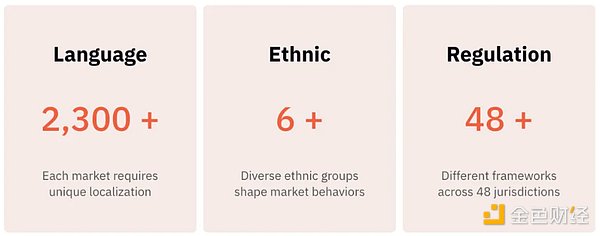
To understand the Asian market, we first need to recognize its diversity and complexity. Asia has more than 2,300 languages, covering different regions such as Northeast Asia, Southeast Asia, Southwest Asia and South Asia, and there are more than 48 regulatory frameworks. Cultural differences within Asia are often greater than those between Western countries.
This diversity has also profoundly affected the Web3 industry in Asia. In Northeast Asia, each country has a unique approach: China implements strict regulation, South Korea combines regulation with incubation support, and Japan promotes the development of Web3 through government initiatives. This unique combination of Asia requires market-specific strategies and nuanced understanding to succeed.
2. Asia's strong growth foundation
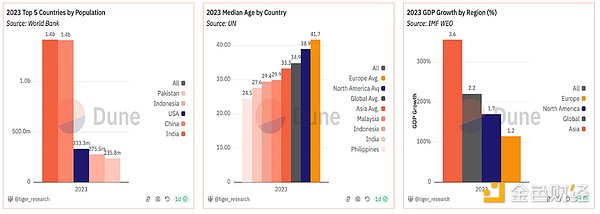
Asia's diversity brings challenges, but its importance cannot be ignored. It has more than 60% of the world's population, contributes 34% of global GDP, and has a growth rate of 3.6%, surpassing North America and Europe.

Asia is in the lead in the Web3 industry for three main reasons:
First, Asia has a huge cryptocurrency user base, with about 60% of global crypto users (320 million people) coming from the region, driven primarily by a young and digitally native population (data source: Triple-A).
Second, Asia excels in trading activity: in early 2024, South Korea's won-based trading volume exceeded its dollar trading volume, and more than half of BN's website traffic recently came from Asia.
Finally, Asia has strong technical talent, including 50 million GitHub developers and 40% of the world's Web3 game developers.
3. Advantages of the Asian Web3 market: consumer-centric and super applications
To popularize the Web3 industry, the key is to develop consumer applications that are easy for the public to use. It is not enough to just build technical infrastructure. This is similar to the development path of the Internet in the past. Killer applications such as email promoted the rapid popularization of the Internet. Similarly, Web3 is expected to achieve widespread popularity through consumer applications that can be naturally integrated into daily life.
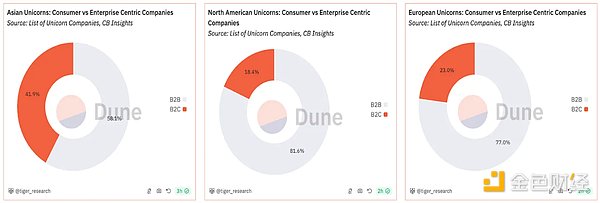
Asia excels in two aspects. First, Asia leads in consumer-centric innovation. As of October 2024, 42% of Asia's unicorns are B2C companies, a proportion that exceeds that of North America and Europe (data source: CB Insights). This advantage stems from Asia's large population of digital natives and advanced mobile payment systems. The consumer-driven development approach makes Asia a hub for new Web3 applications.
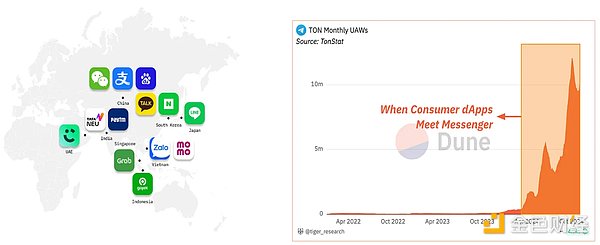
Asia's second biggest advantage is its unique super app ecosystem. Leading platforms such as WeChat, Alipay, Kakao, Line and Grab were originally single-service applications and have now evolved into comprehensive digital ecosystems. These super apps have become part of the daily lives of millions of users, covering a variety of services such as payment, shopping, and entertainment.
TON blockchain demonstrates the potential of Web3 combined with super applications. By adding Web3 functions to the popular social application Telegram, the number of users has surged due to its convenience. These cases show that super applications can lower the barrier to entry to Web3. Introducing new services in an environment familiar to users will promote the popularity of Web3.
4. Data-based analysis of the Asian Web3 market
The Asian market has shown strong potential, but analysis based on expectations and indicators alone may be too superficial. Analyzing real user activities through on-chain data is crucial to gaining a deeper understanding of the market.
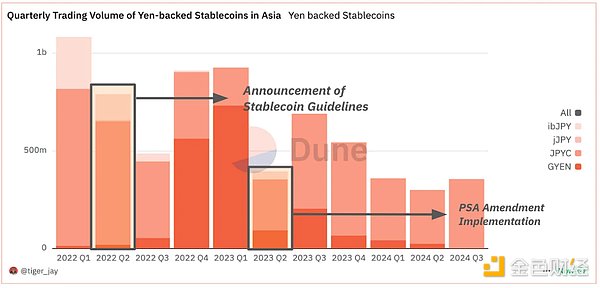
Japan’s changing stablecoin policy highlights the need for in-depth analysis. Despite the introduction of stablecoin guidelines in June 2022 and the legal revision in 2023 allowing the issuance of stablecoins, no significant on-chain impact has yet been seen. This is due to limited application scenarios and regulatory barriers to issuing trust-type stablecoins on public blockchains. In order to bridge the gap between policy and adoption, more detailed on-chain analysis is necessary.
Next, we will evaluate whether the projected growth in the Asian market is being realized through on-chain data analysis.
4.1. Stablecoins in Asia

The use of stablecoins in the Asian market is steadily increasing. This trend is significant because stablecoins are one of the most suitable product-market fits for Web3. On-chain data shows that stablecoin transfers in the Asian region have surged to nearly $8 billion, and transactions are expected to grow further from 2022 to 2024.
Stablecoins pegged to national fiat currencies are creating more real-world application scenarios. Multiple local currency-backed stablecoins have emerged, such as Singapore's XSGD and Indonesia's XIDR. For example, XSGD is connecting with services like Grab, driving real-world adoption. This localized approach and integration with real-world services is increasing stablecoin trading volumes. The continued growth suggests that structural changes are taking place in the Asian market, rather than short-term trends.
4.2. On-chain activity of Asian developers
Asian developers are increasingly involved in smart contract development. On-chain data from the Ethereum mainnet and testnets (Goerli and Sepolia) confirm this trend.

In 2024, Asian developers created approximately 1.7 million contracts on these testnets, a figure that far exceeds activity in North America and Europe. From 2022 onwards, the growth rate is rapid, and a similar trend is also seen on the Ethereum mainnet. Asia's share of contract creation has increased from 4% in 2020 to 40% in 2024.
This change highlights two trends. First, Asian developers are driving blockchain innovation. Second, blockchain development is expanding from its Western origins to the world. High testnet activity reflects active experimentation and also shows that Asian developers are key contributors to the future of Web3.
4.3. Participation of Asian retail investors in decentralized exchange (DEX) transactions
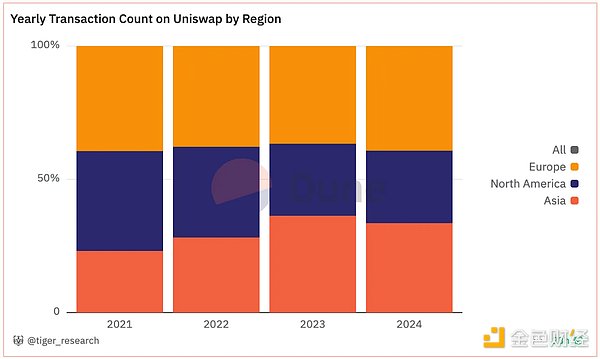
Uniswap's transaction data shows high Asian participation. From 2021 to 2024, Asia has consistently accounted for a significant share of total transaction volume. During this period, transaction activity has steadily increased.
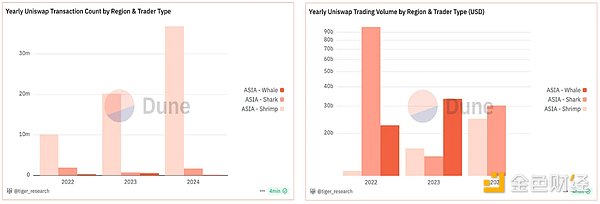
More notable is the difference in participation rates among different types of investors in Asia. When we break down transaction sizes into whales (above $100,000), sharks ($10,000–$100,000), and shrimps (below $10,000), significant changes can be observed. In 2021, shrimp investors accounted for a smaller share of transaction volume. However, by 2024, their share of both the number of transactions and transaction volume has steadily increased. This change is a positive sign that users in the Asian market are increasingly using Web3 services. They not only participate in transactions on centralized exchanges (CEXs), but are also active on decentralized exchanges (DEXs).
4.4. Asian users’ activities in the Web3 social network Farcaster

The activities of Asian users on Farcaster are attracting attention from the Web3 ecosystem. Daily active user (DAU) analysis shows that Asian users are more active than North America and Europe. Although English is the main language of Web3, posts in local languages such as Vietnamese, Chinese, Japanese, and Korean have steadily increased. This shows that Web3 growth in Asia is happening, not just expected. Asia is leading in Web3 usage.
5. Summary
The Asian market is diverse, with unique regulations, cultural differences, and different practices in different countries. This complexity brings challenges and opportunities to Web3. It is critical to understand the unique role of each country. On-chain data reveals the potential of the Asian Web3 market by capturing real user behavior.
Regional analysis based on on-chain data is critical to the growth of the ecosystem. Advances in digital credentials and regional analysis will improve the accuracy of user behavior insights. These tools will help to more clearly understand the regional context and preferences of the Asian Web3 market.







